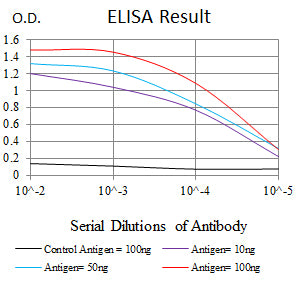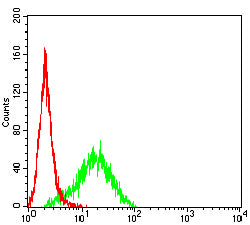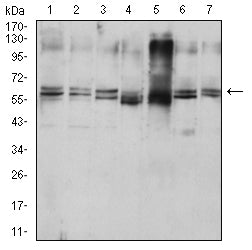


| WB | 1/500 - 1/2000 | Human,Mouse,Rat |
| IF | 咨询技术 | Human,Mouse,Rat |
| IHC | 咨询技术 | Human,Mouse,Rat |
| ICC | 技术咨询 | Human,Mouse,Rat |
| FCM | 1/200 - 1/400 | Human,Mouse,Rat |
| Elisa | 1/10000 | Human,Mouse,Rat |
| Aliases | K9; CK-9; EPPK |
| Entrez GeneID | 3857 |
| clone | 4B3E1 |
| WB Predicted band size | 62kDa |
| Host/Isotype | Mouse IgG2b |
| Antibody Type | Primary antibody |
| Storage | Store at 4°C short term. Aliquot and store at -20°C long term. Avoid freeze/thaw cycles. |
| Species Reactivity | Human, Mouse, Rat |
| Immunogen | Purified recombinant fragment of human KRT9 (AA: 153-460) expressed in E. Coli. |
| Formulation | Purified antibody in PBS with 0.05% sodium azide |
+ +
以下是关于KRT9抗体的3篇参考文献及其摘要概括:
1. **《Mutations in Keratin 9 Cause Palmoplantar Epidermolytic Hyperkeratosis》**
- **作者**:McLean WH, et al.
- **摘要**:该研究首次报道了KRT9基因突变与表皮松解性掌跖角化症(EPPK)的关联,通过免疫组化分析发现KRT9抗体可特异性标记患者皮肤中角蛋白的异常聚集,为疾病诊断提供分子依据。
2. **《Keratin 9 is a Component of the Palmoplantar Epidermal Cytoskeleton》**
- **作者**:Langbein L, et al.
- **摘要**:研究利用KRT9抗体揭示了其在正常人手掌和脚掌表皮中的特异性表达模式,证实KRT9是掌跖部位角质细胞分化的关键标志物,并探讨其维持皮肤屏障功能的作用。
3. **《Development of a Monoclonal Antibody Specific for Keratin 9 and Its Diagnostic Application》**
- **作者**:Suzuki T, et al.
- **摘要**:该文献描述了一种新型KRT9单克隆抗体的开发及验证,证明其在Western blot和免疫荧光中具有高特异性,可用于区分掌跖角化症与其他角蛋白相关皮肤病。
这些研究从疾病机制、分子标记到抗体开发,涵盖了KRT9抗体的基础研究与临床应用方向。
The keratin 9 (KRT9) antibody is a tool used to detect the KRT9 protein, a type I intermediate filament protein encoded by the *KRT9* gene. KRT9 is predominantly expressed in the suprabasal layers of palmoplantar epidermis, where it forms heteropolymers with keratin 1 (KRT1) to provide mechanical resilience to skin subjected to high friction. Its tissue-specific expression makes it a critical marker for studying epidermal differentiation and integrity.
Mutations in *KRT9* are linked to epidermolytic palmoplantar keratoderma (EPPK), an autosomal dominant disorder characterized by thick, blistering skin on palms and soles. KRT9 antibodies aid in diagnosing EPPK by identifying abnormal protein aggregation or loss in skin biopsies. These antibodies are also used in research to explore KRT9's role in epithelial pathologies, including cancer. For example, altered KRT9 expression has been observed in squamous cell carcinomas, suggesting potential diagnostic or prognostic relevance.
Available as monoclonal or polyclonal variants, KRT9 antibodies are applied in immunohistochemistry (IHC), Western blotting (WB), and immunofluorescence (IF) to map protein distribution and expression levels. Their specificity and reliability depend on epitope targets and validation in relevant tissues. Continued research with KRT9 antibodies enhances understanding of keratin-related diseases and epidermal biology, supporting therapeutic development for skin disorders.
×